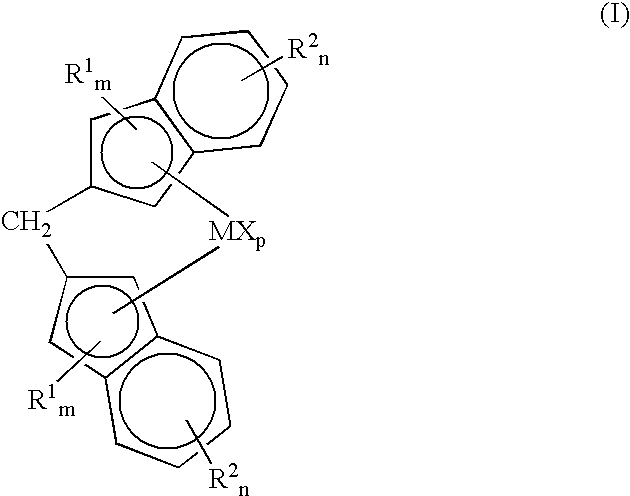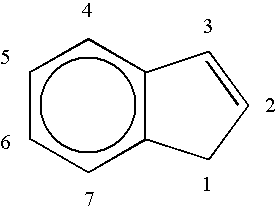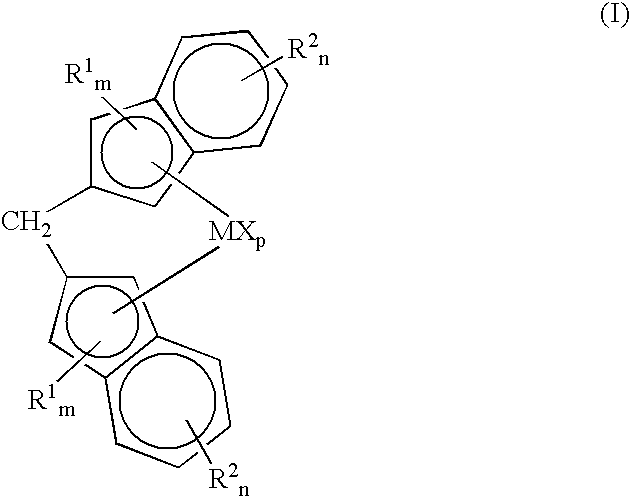Methylene bridged metallocenes as olefin-polymerization-catalyst components
a technology of olefin-polymerization and metallocenes, which is applied in the direction of catalyst activation/preparation, chemical/physical processes, group 5/15 element organic compounds, etc., can solve the problems of not allowing the acquisition of bridged bis(2-indenyl) compounds and not revealing
- Summary
- Abstract
- Description
- Claims
- Application Information
AI Technical Summary
Problems solved by technology
Method used
Image
Examples
examples 5-7
Ethylene Homopolymerization
A 1 L stainless-steel autoclave, equipped with magnetic stirrer, temperature indicator and feeding line for the ethylene, was thermostatted with H.sub.2 O / steam and purified by purging with ethylene at 80.degree. C. Under ethylene purge, 400 mL of n-hexane and 2 mmol TIBA were added; the temperature was brought to 80.degree. C. and the reactor was vented to remove residual nitrogen. The reactor was then pressurized with ethylene up to 11 bar-a. The catalyst solution, comprising the amount of catalyst and cocatalyst reported in Table 3, was injected into the autoclave with ethylene overpressure and the ethylene partial pressure was stabilized to 9.6 bar-a (Ptot=11 bar-a). Polymerization was carried out at 80.degree. C. for the time specified in Table 2, by maintaining a constant ethylene partial pressure. The polymerization was interrupted by degassing unreacted ethylene; the thus obtained polymer was isolated by filtration and dried in vacuum at 60.degree....
examples 12
Ethylene / 1-hexene Copolymerization
A 200 mL glass autoclave, provided with magnetic stirrer, temperature indicator and feeding line for ethylene, was purified and fluxed with ethylene at 35.degree. C. At room temperature were introduced 85 ml of heptane and 5 ml of 1-hexene.
The catalytic system was prepared separately in 10 ml of heptane by consecutively introducing 0.26 mmol of MAO and, after 5 minutes under stirring, 0.1 mg rac-methylene-bis(1-methyl-2-indenyl)zirconium dimethyl (Al / Zr ratio=1000) solved in the lowest possible amount of toluene.
After 5 minutes under stirring, the solution was introduced into the autoclave under ethylene flow; the reactor was closed and the temperature risen to 70.degree. C. The autoclave was then pressurized to 4.5 barg and the total pressure was kept constant by feeding ethylene.
After 10 minutes, the polymerization was stopped by cooling and degassing the reactor, and by introducing 1 ml MeOH. The obtained polymer was washed with acidic MeOH, the ...
examples 13
Ethylene / propylene Copolymerization
A 2.3 L steel autoclave, provided with magnetic stirrer, temperature and pressure controls and indicators and feeding line for the monomers, was purified and fluxed with ethylene at 80.degree. C.
At room temperature were introduced 1000 ml of hexane and 6.0 g of propylene, the temperature risen to 70.degree. C. and the autoclave was pressurized with 9.5 bar of ethylene. The catalytic system was prepared separately in 10 ml Schlenk tube by consecutively introducing 2.31 mmol of MAO (1) and 0.5 mg of rac-methylene-bis(1-methyl-2-indenyl)zirconium dichloride (Al / Zr=2000 as molar ratio) solved in the lowest possible amount of toluene.
After 10 minutes under stirring at 25.degree. C., the solution was injected into the autoclave trough a vial by an ethylene overpressure. The total pressure (10 barg) was kept constant by feeding a mixture of ethylene / propylene in a molar ratio of 37.
After 90 minutes, the polymerization was stopped by cooling and introducin...
PUM
| Property | Measurement | Unit |
|---|---|---|
| dielectric constant | aaaaa | aaaaa |
| molar ratio | aaaaa | aaaaa |
| molar ratio | aaaaa | aaaaa |
Abstract
Description
Claims
Application Information
 Login to View More
Login to View More - R&D
- Intellectual Property
- Life Sciences
- Materials
- Tech Scout
- Unparalleled Data Quality
- Higher Quality Content
- 60% Fewer Hallucinations
Browse by: Latest US Patents, China's latest patents, Technical Efficacy Thesaurus, Application Domain, Technology Topic, Popular Technical Reports.
© 2025 PatSnap. All rights reserved.Legal|Privacy policy|Modern Slavery Act Transparency Statement|Sitemap|About US| Contact US: help@patsnap.com



